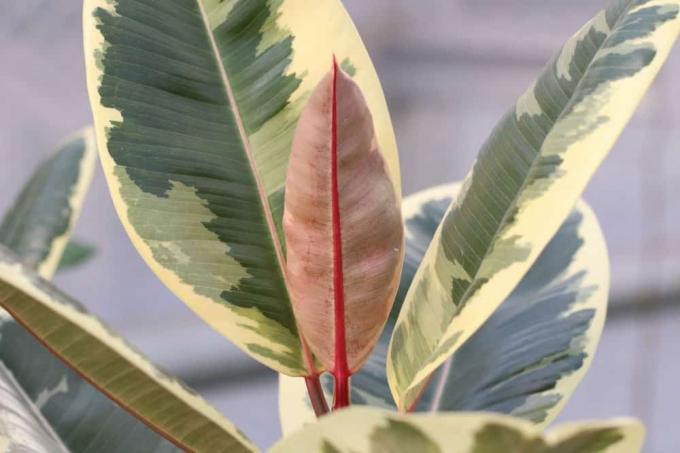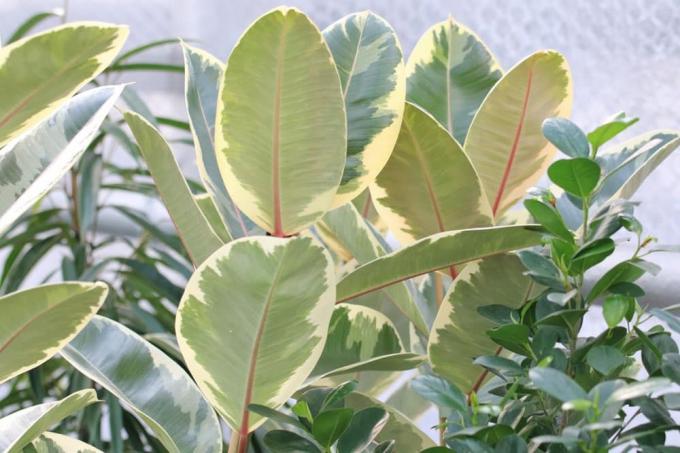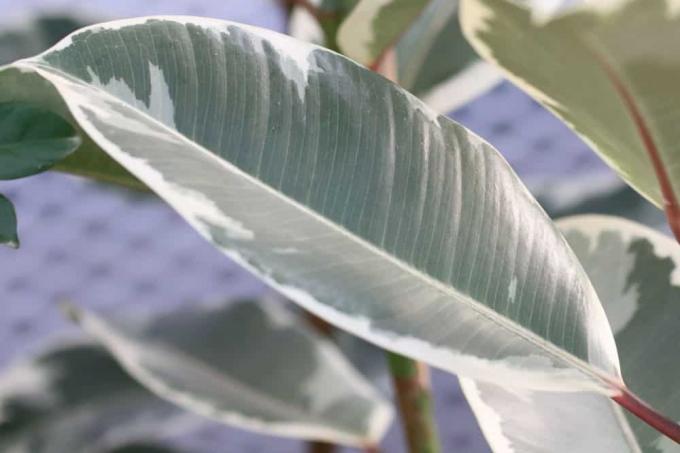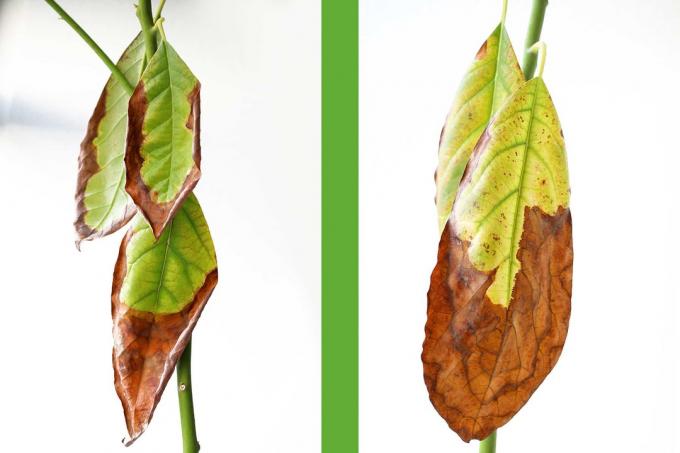

Table of contents
- Popular ornamental plant
- Pour right
- nutrient
- lack of space
- Measures to be taken in the event of complete leaf loss
- sorts
- Conclusion
Ficus elastica is not a relic from the past, but still enjoys great popularity as a houseplant. With its impressive size, the Asian plant adorns reception areas, waiting rooms, offices and living rooms. The wood is considered robust, maintenance is easy and takes little time. Nevertheless, various causes can lead to the resistant plants losing their leaves. The reason for this is not always immediately apparent at first glance.
Popular ornamental plant
The rubber tree is one of the classic indoor plants. Since the 1960s, the mulberry plant has adorned domestic living and office spaces with its imposing size. In optimal conditions, the plant can reach an impressive height of over 3 meters with its rich green and glossy leaves. In general, the ficus, which comes from Asia, is considered robust and requires little maintenance. The plant can easily cope with short-term drought.
It is also not uncommon for Ficus elastica to lose many of its older leaves in winter. The wood thus reacts to the changed light conditions. If all conditions are met, the plant becomes a perennial, lush growing companion. However, the hardy plants do not tolerate everything. Various causes can lead to discoloration and shedding of the leaves.
Pour right
The rubber tree loves a bright spot in living rooms, in the office or in the conservatory. At temperatures above 18° C, the plant from the mulberry family develops its attractive foliage. The wood should not be exposed to a colder environment. How light or dark the location can be depends on the respective variety. Ficus elastica tricolor, for example, needs more sunlight than the dark green colored Ficus elastica robusta for the conspicuous leaf coloration.
With plants bought from the supermarket, the changed light conditions can lead to the shedding of individual leaves. The plants need some time before they get used to the new habitat. If older rubber trees lose their leaves without changing their location, caution is advised. A possible cause could be the wrong supply of water.
- Thrives in sunny to partially shaded locations
- Does not tolerate blazing midday sun
- Ficus are sensitive to waterlogging
- Calcareous water does not harm the plants
- The top layer of substrate must be dry before watering
- Water moderately between October and February
If your rubber tree sheds a lot of leaves, the first thing you should do is check the soil's moisture level. The Asian shrubs can cope with a brief drought. If the plant is not watered for a long period of time, the foliage loses its firm structure and takes on a sallow colour. Standing water in the pot or Coasters can also lead to shedding of leaves. Waterlogging can have a dangerous effect on the mulberry plant. Fungal pathogens use the moist environment and attack the roots of the weakened plants.

The root rot caused cannot be cured by fungicides or other home remedies. In addition to proper watering, drainage at the bottom of the tub can protect the underground parts of the rubber tree. The immersion method has proven itself for watering the Asian ornamental trees. With this measure, the entire planter is immersed in lukewarm water until no more air bubbles rise from the substrate.
If the soil is completely dry, this method may need to be repeated several times. The water must completely penetrate the entire globe. During the main growing season, this process should be carried out approximately every 14 days. Between October and February, the plant reduces its metabolism to a minimum, and the water requirement is also reduced.
Tip:
Give the plant a full shower every now and then. With this method, the dust and dirt film is rinsed off the leaves.
nutrient
In addition to a too dark or airy location or the wrong watering, nutrients can also be responsible for the loss of the leaves. The rubber tree is one of the weakly consuming plants. Too high a dose of fertilizer clogs the roots of the plant and can lead to damage. The foliage turns a pale yellow color and dies.
- Stop nutrient supply in winter
- A liquid or Slow-release fertilizer has proven its worth between March and August
- Fertilize approximately 21 days apart
- Reduce the amount of fertilizer indicated on the packaging
Organic fertilizers such as compost, coffee grounds or rock dust are unsuitable for indoor plants. The small vessels lack the microorganisms that convert the material into valuable nutrients in a short time. In many cases, rot occurs, which can damage the trees. However, the ficus has no objection to an occasional dose of diluted nettle broth. Over-fertilization can also cause similar symptoms in the plants. In this case, move the ficus to fresh substrate and stop fertilizing completely for one to two months. The ornamental trees need a little longer to regenerate from such damage.
lack of space
The exotic plants with the leathery leaves grow slowly. Rubber trees only need to be transplanted into a new, larger container about every 2 to 3 years. If you delay this measure unnecessarily, it can have a negative effect on the development of the plants. The result is stunted growth and the loss of leaves. When the roots of the shrubs completely fill the pot, it must be repotted. Unless it is an emergency, you should do this work in the spring.
- Remove the old substrate generously
- Create a drainage in the new bucket
- The new vessel should only be slightly larger than the one previously used
The plants are suitable for cultivation in hydroponics. However, don't make the mistake of switching from earth to inorganic materials. Because the substrate must be completely removed from the roots so that no mold can form in the humid environment. If you repot older trees, you should always use the material you have been using up until now.

Tip:
Rubber trees can become "top heavy" as they age. If necessary, weigh down the soil decoratively with stones so that the plant does not become a victim of gravity.
Measures to be taken in the event of complete leaf loss
It is unusual for a mulberry to lose all its leaves. If the root system is intact and does not show any major damage, the Ficus elastica is not yet a case for household waste.
- Check the underground plant parts
- Move the plant to a semi-shady, warm location
- Do not let the substrate dry out
- Don't fertilize
Due to the slow growth, it can take 2 to 3 months before new buds appear. Don't lose patience. Pruning the plant is not always successful. If done incorrectly, this measure can also lead to the death of the rubber tree. In the area of the woody stems, the wood no longer sprout. Leave a few inches of unwoody shoots.
You can try a trick to encourage the plant to sprout new leaves quickly:
- Score slightly woody shoots with a sharp knife
- The interface with a wet handkerchief or wrap cotton
- Keep the material moist
- Check after 3 to 4 weeks
- Room temperature should be between 18° and 22°C
It makes sense to find the reason for the complete loss of foliage. If location is a possible cause, you should avoid that place in the future.
sorts
The different varieties of "Ficus elastica" make different demands on their location. In order to avoid losing the leaves, the right place should be found for each rubber tree.
Ficus elastica tricolor
This ornamental tree belongs to the ornamental foliage plants. The strikingly colored leaves with the yellow-red edge need a lot of light to develop their full splendor. A few hours of sunshine a day are enough.
Ficus elastica variegeta
The yellow-edged and spotted leaves distinguish this rubber tree variety. The location should be bright, but avoid direct sunlight.
Ficus elastica doerschi
Closely related to the Ficus tricolor variety. The distinctive feature of this rubber tree is its gray and cream leaf pattern. A bright spot in the warm living room or Office encourages the growth of this showy strain.
Ficus elastica robusta
As the name suggests, this rubber tree is resilient. Due to its dark green, rounded foliage, it can easily cope with partially shaded locations.
Black elastica Prince
This subspecies also has rounded leaves with a deep green color.

Conclusion
Cultivation of Ficus elastica is easy. Despite its resilience, the rubber tree The increased shedding of leaves in rubber trees is not without reason. It makes sense to quickly find the reason for this in order to protect the wood from further damage.
 Home editorial office
Home editorial office
Learn more about houseplants

Avocado Leaves Turning Brown: 8 Common Causes
The avocado is a real nutrient bomb and is considered a so-called superfood, even if there is still no consensus as to whether it belongs to vegetables or fruit. In this country it is mainly cultivated as a decorative houseplant.

Properly multiply ornamental asparagus | Tips for Asparagus densiflorus
The ornamental asparagus, better the ornamental asparagus species Asparagus densiflorus, is considered to be easy to care for - but in many households it dies after a short time. Because the feathered plant has low demands, but these must be met regularly. This is the only way the plant will later reward you with fragrant flowers.

Monstera Gets Brown Spots - What To Do?
The large green leaves of the Monstera bring an exotic flair to the living room at home. Unfortunately, it is not uncommon for brown or black spots to form on the foliage.

Elephant foot: brown tips, loses leaves - 10 effective tips
With its drought tolerance, the elephant's foot is one of the asparagus plants that are not very complicated to care for. Still, some problems such as brown leaf tips can occur if the Ponytail Palm is sited incorrectly or the tree has been watered over.

Euphorbia lactea 'Cristata' - care instructions
Not only its unusual appearance, but also the easy care makes the Euphorbia lactea 'Cristata' a popular houseplant in our latitudes. Although the plant is colloquially referred to as a coral cactus, it is actually not a cactus but a combination of two succulents joined together.

Plant diseases on indoor plants - recognize and combat
Numerous plant diseases are caused by microscopic organisms, including bacteria, fungi and viruses. These penetrate plant cells and damage the entire plant, often fatally. In addition, animal pests can also extremely weaken indoor plants. Early detection and immediate remedial measures are important in order to save infested plants.



